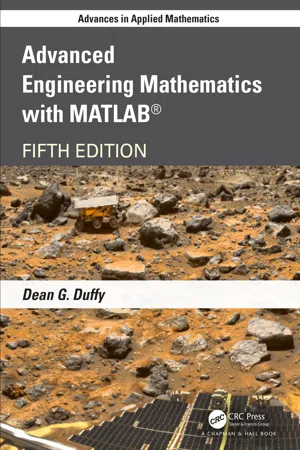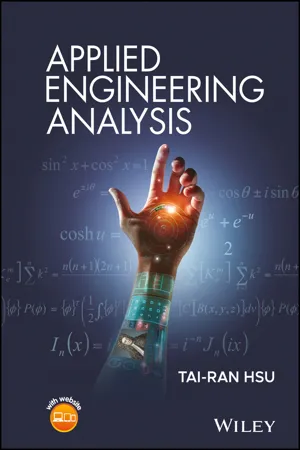Technology & Engineering
Particular Solution for Differential Equation
A particular solution for a differential equation is a specific solution that satisfies the given differential equation. It is obtained by incorporating initial conditions or boundary conditions into the general solution. In engineering and technology, particular solutions are essential for finding specific solutions to differential equations that model physical systems.
Written by Perlego with AI-assistance
Related key terms
Related key terms
1 of 4
Related key terms
1 of 3
4 Key excerpts on "Particular Solution for Differential Equation"
- eBook - ePub
- Dean G. Duffy(Author)
- 2021(Publication Date)
- Chapman and Hall/CRC(Publisher)
particular solution.• Example 1.1.1
Consider the differential equation= x + 1 , yd yd x( 1 )= 2.(1.1.20)This condition y(1) = 2 is called an initial condition and the differential equation plus the initial condition constitute an initial-value problem. Straightforward integration givesy( x )=+ C =∫(d xx + 1)1 2x 2+ x + C .(1.1.21)Equation 1.1.21 is the general solution to the differential equation, Equation 1.1.20, because it is a solution to the differential equation for every choice of C. However, if we now satisfy the initial condition y(1) = 2, we obtain a particular solution. This is done by substituting the corresponding values of x and y into Equation 1.1.21, orTherefore, the solution to the initial-value problem Equation 1.1.20 is the particular solution2 =1 2+ 1 + C =( 1 )23 2+ C , o r C =1 2.(1.1.22)y( x )=/2(x + 1)2.(1.1.23)Finally, it must be admitted that most differential equations encountered in the “real” world cannot be written down either explicitly or implicitly. For example, the simple differential equation y′ = f (x) does not have an analytic solution unless you can integrate f (x) - eBook - ePub
Mathematical Methods for Finance
Tools for Asset and Risk Management
- Sergio M. Focardi, Frank J. Fabozzi, Turan G. Bali(Authors)
- 2013(Publication Date)
- Wiley(Publisher)
The solutions to a differential equation or system of differential equations can be as simple as explicit formulas. When an explicit formula is not possible to obtain, various numerical methods can be used to approximate a solution. Even in the absence of an exact solution, properties of solutions of a differential equation can be determined. A large number of properties of differential equations have been established over the last three centuries. In this chapter, we provide only a brief introduction to the concept of differential equations and their properties, limiting our discussion to the principal concepts. We do not cover stochastic differential equations.DIFFERENTIAL EQUATIONS DEFINED A differential equation is a condition expressed as a functional link between one or more functions and their derivatives. It is expressed as an equation (that is, as an equality between two terms). A solution of a differential equation is a function that satisfies the given condition. For example, the conditionequates to zero a linear relationship between an unknown function Y (x ), its first and second derivatives Y′ (x ), Y ″ (x ), and a known function b (x ). (In some equations, we denote the first and second derivatives by a single and double prime, respectively.) The unknown function Y (x ) is the solution of the equation that is to be determined.There are two broad types of differential equations: ordinary differential equations and partial differential equations. Ordinary differential equations are equations or systems of equations involving only one independent variable. Another way of saying this is that ordinary differential equations involve only total derivatives. In contrast, partial differential equations are differential equations or systems of equations involving partial derivatives. That is, there is more than one independent variable.ORDINARY DIFFERENTIAL EQUATIONS In full generality, an ordinary differential equation (ODE) can be expressed as the following relationship:where Y(m )(x ) denotes the m th derivative of an unknown function Y (x ). If the equation can be solved for the n - Ramin S. Esfandiari(Author)
- 2017(Publication Date)
- CRC Press(Publisher)
10Numerical Solution of Partial Differential EquationsPartial differential equations play an important role in several areas of engineering ranging from fluid mechanics, heat transfer, and applied mechanics to electromagnetic theory. Since it is generally much more difficult to find a closed-form solution for partial differential equations than it is for ordinary differential equations, they are usually solved numerically. In this chapter, we present numerical methods for solution of partial differential equations, in particular, those that describe some fundamental problems in engineering applications, including Laplace’s equation, the heat equation, and the wave equation.10.1 IntroductionA partial differential equation (PDE) is an equation involving a function (dependent variable) of at least two independent variables, and its partial derivatives. A PDE is of order n if the highest derivative is of order n . If a PDE is of the first degree in the dependent variable and its partial derivatives, it is called linear. Otherwise, it is nonlinear. If each term in a PDE involves either the dependent variable or its partial derivatives, the PDE is called homogeneous. Otherwise, it is nonhomogeneous.Suppose u = u (x , y ). Then, the following brief notations for partial derivatives are used:u x=,∂ u∂ xu=x x,∂ 2u∂x 2u=x y∂ 2u∂ y ∂ xThe dimension of a PDE is determined by the number of spatial coordinates, not time t . For example, a PDE with u = u (x , y , z ) as its dependent variable is three-dimensional, while a PDE with dependent variable u = u (x , t ) is one-dimensional.Consider a class of linear, second-order PDEs that appear in the formau+ 2 bx xu+ cx yu= f ( x , y , u ,y yu x,u y)( 10.1 )A PDE in the form of Equation 10.1 is• Elliptic if b 2 − ac < 0• Parabolic if b 2 − ac =- eBook - ePub
- Tai-Ran Hsu(Author)
- 2018(Publication Date)
- Wiley(Publisher)
Section 2.2.5 .- 2. Partial differential equations (PDEs): Equations with functions that involve more than one variable and “partial” derivatives as described in Section 2.2.5 .
It also explained in Section 2.5 that differential equations are derived from relevant laws of physics. Laws of physics used frequently in mechanical engineering analyses include- Newton's laws for statics, dynamics, and kinematics of solids.
- Fourier's law for heat conduction in solids.
- Newton's cooling law for convective heat transfer in fluids.
- Fick's law for diffusion of dissimilar substances in mixing.
- Bernoulli's principle for fluids in motion.
- The law of conservation of mass.
- The law of conservation of energy.
- The law of conservation of momentum.
In this chapter, we will review methods commonly used to solve first-order differential equations. We will find that although they appear simple in form these differential equations can be used to solve a number of engineering problems in fluid mechanics, heat transfer, and kinematics of rigid bodies.7.2 Solution Methods for First-order Ordinary Differential Equations
Solution methods for first-order ordinary differential equations are taught in freshman and sophomore year math courses in most engineering institutions. In this section we will refresh the solution methods that are most commonly used.
Index pages curate the most relevant extracts from our library of academic textbooks. They’ve been created using an in-house natural language model (NLM), each adding context and meaning to key research topics.
Explore more topic indexes
Explore more topic indexes
1 of 6
Explore more topic indexes
1 of 4



